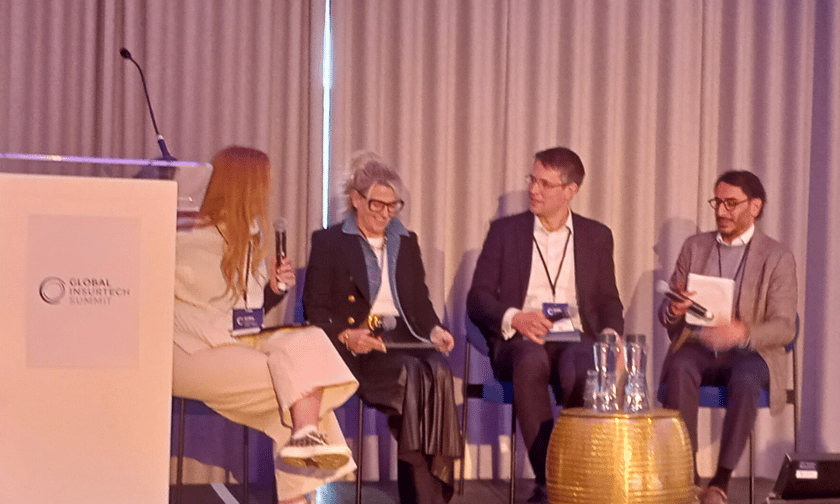

During a panel discussion on ‘Optimising Data Utilisation in the 2024 Broking Landscape’ at the 2024 Global Insurtech Summit, Taffy Jo Meyers (pictured centre, left) shared her insights into the critical role people and culture play in the success of transformation programmes.
She was backed by panel chair Lisa Wardlaw (pictured left), president and founder of 360 Digital Immersion, who noted that many insurance businesses have access to the same chequebooks, technologies and capabilities.
“We need people who are conceptually dexterous, who can see beyond the traditional linear view that we have of functions, of roles, to start to see patterns,” she said. “And it all comes down to talent.”
Global head of digitisation at the insurance broker Nacora Group, Jens Weir (pictured right) noted that while effective strategic planning requires looking five-to-10 years into the future, it’s hard to predict where the insurance intermediary will stand in the industry in five-to-10 years’ time. What we do know, he said, is that the landscape is going to change, and that the sector is now standing at the brink of transformational change at a speed perhaps never seen before.
“In my 20 years of experience in insurance, I consider that it has never been as exciting as it is now and in the years in to come, because we are running fast forward into the unknown,” he said. “Especially for the intermediaries, they really need to position themselves for their future existence. And I think that the industry really needs the kind of people who want to be part of this journey.”
Weir highlighted that while having the right technical and hard skills is critical, there is a real requirement for the industry to bring people along on its transformation journey if it’s going to attract the calibre of talent required to shape how the intermediary space will evolve over the next five-to-10 years. In order to stand out, he said, insurance needs to able to demonstrate a strong, passion-led culture, and be able to communicate that, as it’s a critical tool in attracting great young talent.
“We can’t solve new problems with old thinking and old ways, just as we can’t solve new problems with old technology,” added Meyers. “… So how do we bring that new way of thinking in? It really is about looking at diversity of talent and diversity of talent pools, and sourcing the non-traditional insurance professional.
“Also, I think it’s about the collaboration experience of bringing in technologists, bringing in SMEs from the industries we seek to serve - or other facets, whether it’s university collaborations, and working deeply with some of the think tanks and the economists, etc.”
Meyer emphasised that getting a handle on the behavioural economics at play is essential. What are the behavioural drivers that fuel the economic decisions of risk managers, of CFOs, of all those individuals placing the risk and thinking about how to manage that risk, she asked? All of those individuals exist in other industries including the personal lines and direct insurance markets, which can be easy to forget about as an intermediated business.
“[As something of an insurance evangelist], I fully believe that we have a messaging problem, and we have a problem attracting talent to the industry,” she said. “And we’ve got to get better at [communicating] our message and purpose. We are a purpose driven industry that serves for economic stability, as well as societal safety.
“These are the things that pull on the heartstrings of that next generation. We also have to get better at providing an environment where the screen generation isn’t doing manual, mundane work. They’re doing work where they are in front of the screen, and they can recognise information quickly and can sort out ambiguities, as opposed to having to wade through the minutiae of lines and rows of data that don’t tell them the story.”
Adding his take on the importance of having greater diversity of talent in insurance, Ben Shannon (pictured centre, right), global digital and innovation leader, facultative reinsurance at Aon, noted that this represents a “serious opportunity” for the sector. The industry needs to get better at promoting what a career in insurance can look like, he said, and move away from the idea that you have to start as a claims handler, then progress to become a client advocate and then a junior broker, and later pay your dues for 20 years to lead a broking team.
“There are so many different career pathways that we’re still unpicking and still discovering,” he said. “Digital innovation and data are going to organically drive where those pathways can go. You don’t need to be wired up as a specific type of traditional broker to find satisfaction in this industry. I think broking houses have a responsibility to be agile when it comes to trying to employ talent.
“I think we’ve all been in the position where you try staff or have seen staff hired into our companies and they fall flat, because we recognise the need for machine-learning or AI experts, but without the fundamental infrastructure and the resolution of legacy system issues, they’re not going to have the foundation to be able to grow and develop. So, there needs to be a broader view on how and when these talent pools should be drawn on.”
